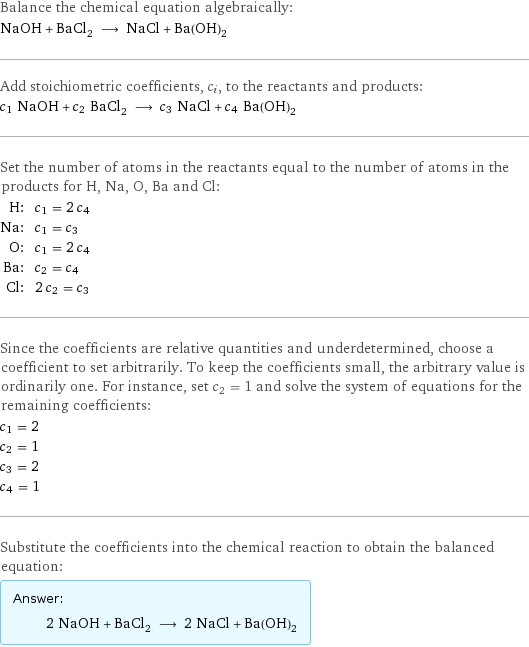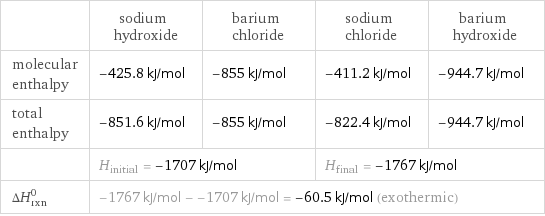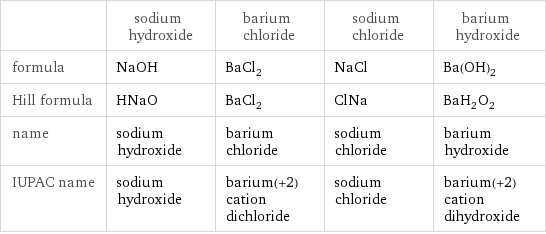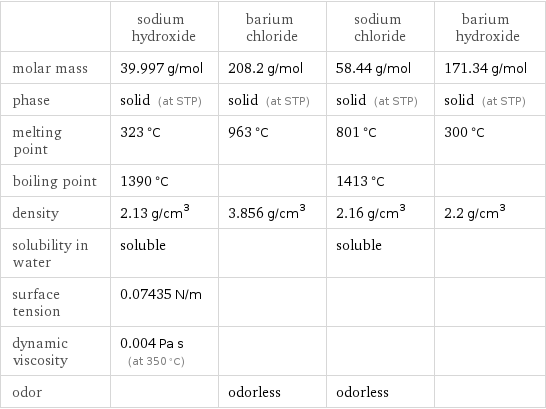Input interpretation

NaOH sodium hydroxide + BaCl_2 barium chloride ⟶ NaCl sodium chloride + Ba(OH)_2 barium hydroxide
Balanced equation

Balance the chemical equation algebraically: NaOH + BaCl_2 ⟶ NaCl + Ba(OH)_2 Add stoichiometric coefficients, c_i, to the reactants and products: c_1 NaOH + c_2 BaCl_2 ⟶ c_3 NaCl + c_4 Ba(OH)_2 Set the number of atoms in the reactants equal to the number of atoms in the products for H, Na, O, Ba and Cl: H: | c_1 = 2 c_4 Na: | c_1 = c_3 O: | c_1 = 2 c_4 Ba: | c_2 = c_4 Cl: | 2 c_2 = c_3 Since the coefficients are relative quantities and underdetermined, choose a coefficient to set arbitrarily. To keep the coefficients small, the arbitrary value is ordinarily one. For instance, set c_2 = 1 and solve the system of equations for the remaining coefficients: c_1 = 2 c_2 = 1 c_3 = 2 c_4 = 1 Substitute the coefficients into the chemical reaction to obtain the balanced equation: Answer: | | 2 NaOH + BaCl_2 ⟶ 2 NaCl + Ba(OH)_2
Structures

+ ⟶ +
Names

sodium hydroxide + barium chloride ⟶ sodium chloride + barium hydroxide
Reaction thermodynamics
Enthalpy

| sodium hydroxide | barium chloride | sodium chloride | barium hydroxide molecular enthalpy | -425.8 kJ/mol | -855 kJ/mol | -411.2 kJ/mol | -944.7 kJ/mol total enthalpy | -851.6 kJ/mol | -855 kJ/mol | -822.4 kJ/mol | -944.7 kJ/mol | H_initial = -1707 kJ/mol | | H_final = -1767 kJ/mol | ΔH_rxn^0 | -1767 kJ/mol - -1707 kJ/mol = -60.5 kJ/mol (exothermic) | | |
Equilibrium constant
![Construct the equilibrium constant, K, expression for: NaOH + BaCl_2 ⟶ NaCl + Ba(OH)_2 Plan: • Balance the chemical equation. • Determine the stoichiometric numbers. • Assemble the activity expression for each chemical species. • Use the activity expressions to build the equilibrium constant expression. Write the balanced chemical equation: 2 NaOH + BaCl_2 ⟶ 2 NaCl + Ba(OH)_2 Assign stoichiometric numbers, ν_i, using the stoichiometric coefficients, c_i, from the balanced chemical equation in the following manner: ν_i = -c_i for reactants and ν_i = c_i for products: chemical species | c_i | ν_i NaOH | 2 | -2 BaCl_2 | 1 | -1 NaCl | 2 | 2 Ba(OH)_2 | 1 | 1 Assemble the activity expressions accounting for the state of matter and ν_i: chemical species | c_i | ν_i | activity expression NaOH | 2 | -2 | ([NaOH])^(-2) BaCl_2 | 1 | -1 | ([BaCl2])^(-1) NaCl | 2 | 2 | ([NaCl])^2 Ba(OH)_2 | 1 | 1 | [Ba(OH)2] The equilibrium constant symbol in the concentration basis is: K_c Mulitply the activity expressions to arrive at the K_c expression: Answer: | | K_c = ([NaOH])^(-2) ([BaCl2])^(-1) ([NaCl])^2 [Ba(OH)2] = (([NaCl])^2 [Ba(OH)2])/(([NaOH])^2 [BaCl2])](../image_source/ac17c551f7afcbba9d10df4983be8935.png)
Construct the equilibrium constant, K, expression for: NaOH + BaCl_2 ⟶ NaCl + Ba(OH)_2 Plan: • Balance the chemical equation. • Determine the stoichiometric numbers. • Assemble the activity expression for each chemical species. • Use the activity expressions to build the equilibrium constant expression. Write the balanced chemical equation: 2 NaOH + BaCl_2 ⟶ 2 NaCl + Ba(OH)_2 Assign stoichiometric numbers, ν_i, using the stoichiometric coefficients, c_i, from the balanced chemical equation in the following manner: ν_i = -c_i for reactants and ν_i = c_i for products: chemical species | c_i | ν_i NaOH | 2 | -2 BaCl_2 | 1 | -1 NaCl | 2 | 2 Ba(OH)_2 | 1 | 1 Assemble the activity expressions accounting for the state of matter and ν_i: chemical species | c_i | ν_i | activity expression NaOH | 2 | -2 | ([NaOH])^(-2) BaCl_2 | 1 | -1 | ([BaCl2])^(-1) NaCl | 2 | 2 | ([NaCl])^2 Ba(OH)_2 | 1 | 1 | [Ba(OH)2] The equilibrium constant symbol in the concentration basis is: K_c Mulitply the activity expressions to arrive at the K_c expression: Answer: | | K_c = ([NaOH])^(-2) ([BaCl2])^(-1) ([NaCl])^2 [Ba(OH)2] = (([NaCl])^2 [Ba(OH)2])/(([NaOH])^2 [BaCl2])
Rate of reaction
![Construct the rate of reaction expression for: NaOH + BaCl_2 ⟶ NaCl + Ba(OH)_2 Plan: • Balance the chemical equation. • Determine the stoichiometric numbers. • Assemble the rate term for each chemical species. • Write the rate of reaction expression. Write the balanced chemical equation: 2 NaOH + BaCl_2 ⟶ 2 NaCl + Ba(OH)_2 Assign stoichiometric numbers, ν_i, using the stoichiometric coefficients, c_i, from the balanced chemical equation in the following manner: ν_i = -c_i for reactants and ν_i = c_i for products: chemical species | c_i | ν_i NaOH | 2 | -2 BaCl_2 | 1 | -1 NaCl | 2 | 2 Ba(OH)_2 | 1 | 1 The rate term for each chemical species, B_i, is 1/ν_i(Δ[B_i])/(Δt) where [B_i] is the amount concentration and t is time: chemical species | c_i | ν_i | rate term NaOH | 2 | -2 | -1/2 (Δ[NaOH])/(Δt) BaCl_2 | 1 | -1 | -(Δ[BaCl2])/(Δt) NaCl | 2 | 2 | 1/2 (Δ[NaCl])/(Δt) Ba(OH)_2 | 1 | 1 | (Δ[Ba(OH)2])/(Δt) (for infinitesimal rate of change, replace Δ with d) Set the rate terms equal to each other to arrive at the rate expression: Answer: | | rate = -1/2 (Δ[NaOH])/(Δt) = -(Δ[BaCl2])/(Δt) = 1/2 (Δ[NaCl])/(Δt) = (Δ[Ba(OH)2])/(Δt) (assuming constant volume and no accumulation of intermediates or side products)](../image_source/e487e7f6af190c4845ee5715d3ac83e0.png)
Construct the rate of reaction expression for: NaOH + BaCl_2 ⟶ NaCl + Ba(OH)_2 Plan: • Balance the chemical equation. • Determine the stoichiometric numbers. • Assemble the rate term for each chemical species. • Write the rate of reaction expression. Write the balanced chemical equation: 2 NaOH + BaCl_2 ⟶ 2 NaCl + Ba(OH)_2 Assign stoichiometric numbers, ν_i, using the stoichiometric coefficients, c_i, from the balanced chemical equation in the following manner: ν_i = -c_i for reactants and ν_i = c_i for products: chemical species | c_i | ν_i NaOH | 2 | -2 BaCl_2 | 1 | -1 NaCl | 2 | 2 Ba(OH)_2 | 1 | 1 The rate term for each chemical species, B_i, is 1/ν_i(Δ[B_i])/(Δt) where [B_i] is the amount concentration and t is time: chemical species | c_i | ν_i | rate term NaOH | 2 | -2 | -1/2 (Δ[NaOH])/(Δt) BaCl_2 | 1 | -1 | -(Δ[BaCl2])/(Δt) NaCl | 2 | 2 | 1/2 (Δ[NaCl])/(Δt) Ba(OH)_2 | 1 | 1 | (Δ[Ba(OH)2])/(Δt) (for infinitesimal rate of change, replace Δ with d) Set the rate terms equal to each other to arrive at the rate expression: Answer: | | rate = -1/2 (Δ[NaOH])/(Δt) = -(Δ[BaCl2])/(Δt) = 1/2 (Δ[NaCl])/(Δt) = (Δ[Ba(OH)2])/(Δt) (assuming constant volume and no accumulation of intermediates or side products)
Chemical names and formulas

| sodium hydroxide | barium chloride | sodium chloride | barium hydroxide formula | NaOH | BaCl_2 | NaCl | Ba(OH)_2 Hill formula | HNaO | BaCl_2 | ClNa | BaH_2O_2 name | sodium hydroxide | barium chloride | sodium chloride | barium hydroxide IUPAC name | sodium hydroxide | barium(+2) cation dichloride | sodium chloride | barium(+2) cation dihydroxide
Substance properties

| sodium hydroxide | barium chloride | sodium chloride | barium hydroxide molar mass | 39.997 g/mol | 208.2 g/mol | 58.44 g/mol | 171.34 g/mol phase | solid (at STP) | solid (at STP) | solid (at STP) | solid (at STP) melting point | 323 °C | 963 °C | 801 °C | 300 °C boiling point | 1390 °C | | 1413 °C | density | 2.13 g/cm^3 | 3.856 g/cm^3 | 2.16 g/cm^3 | 2.2 g/cm^3 solubility in water | soluble | | soluble | surface tension | 0.07435 N/m | | | dynamic viscosity | 0.004 Pa s (at 350 °C) | | | odor | | odorless | odorless |
Units
